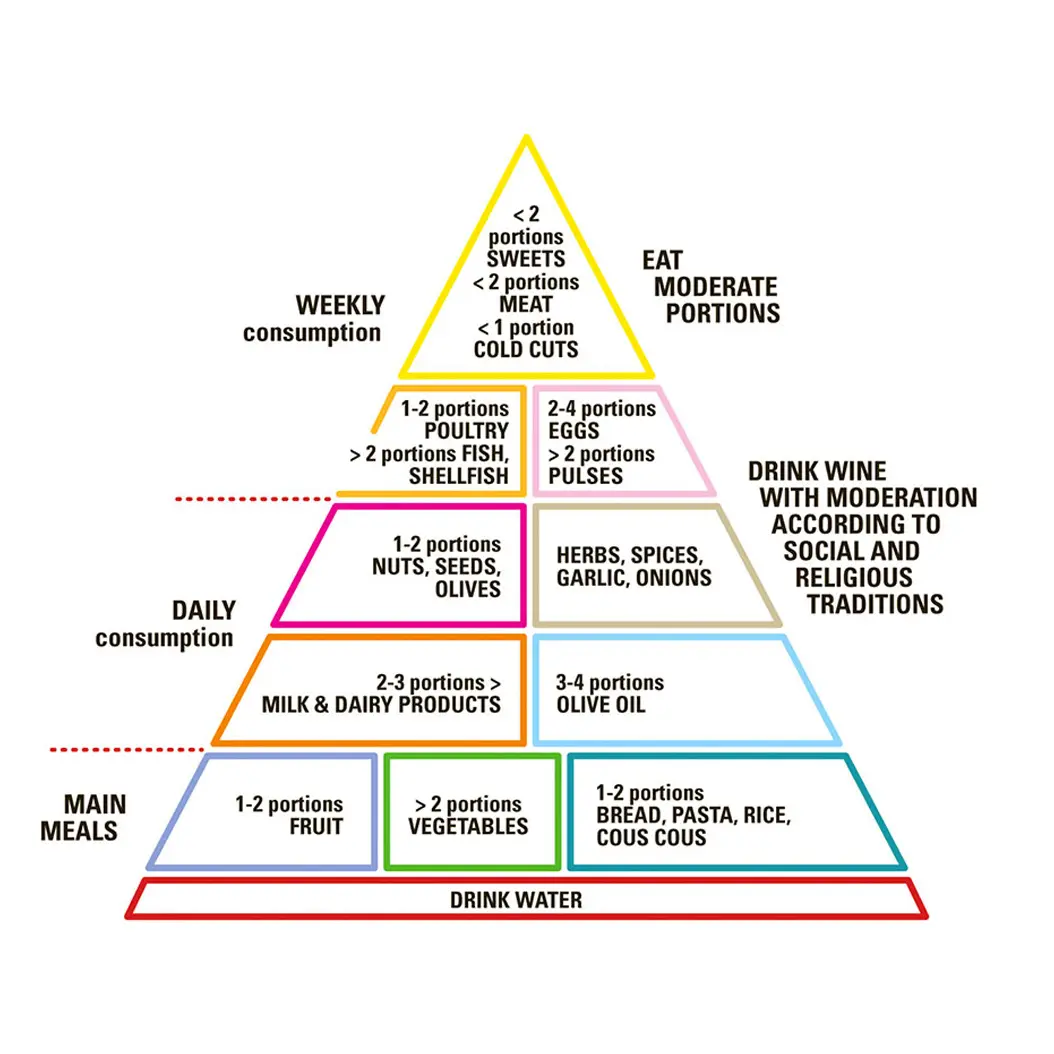
A food pyramid is a diagram representing the ideal proportions of food that we should eat daily and weekly.
Its purpose is to give simple guidelines on what and how much to eat from every food group.
At the base of the pyramid are foods that should be eaten on a daily basis. The higher a food is on the food pyramid, the lower the recommended intake. On the tip of the pyramid are the foods that should be eaten occasionally.
The aim is to promote a healthy diet that provides all the nutrients necessary to our body, in order to avoid weight-related diseases.
Water is at the base of the food pyramid and is incredibly precious for our health. Therefore, it’s important to drink about 1.5 – 2 litres of water per day. You can also enjoy a nice cup of unsweetened tea or herbal tea, which can be flavoured with a slice of lemon.
Two groups of foods belong to the second level: plant foods and grain-based foods. Don’t be shy with fruit and vegetables: plant foods should be eaten at least 3 times a day (4 or 5 is even better).
Instead, foods of the grain group – pasta, rice, spelt, barley, corn, etc. – should be consumed 2-3 times a day. Remember that whole grains are always a healthier option.
Dairy products should be consumed once a day, twice a day from time to time. However, 3-4 daily servings of olive oil are allowed.
It is better to choose extra virgin olive oil, which contains polyunsaturated and monounsaturated fats, but using herbs and spices for seasoning our food is an even healthier choice, in order to limit our salt intake. 1 portion a day of nuts gives you the right amount of Omega-3 fatty acids.
On the higher levels of the pyramid are foods that should be consumed weekly. White meat, such as seafood and chicken, should be eaten twice a week (fish even 3-4 times a week).
I recommend eating 2 servings of legumes on a weekly basis, since they contain a good amount of fibre, protein and complex carbohydrates. Eggs should be eaten only once a week.
Cured meats are full of salt, therefore it’s better to avoid eating them on a weekly basis, while I recommend eating red meat once a week – preferably lean cuts.
Sweets, biscuits, juices, snacks, chips, etc. should be eaten OCCASIONALLY.
**INRAN is a public research body engaged in research, reporting and promotional activities regarding food and nutrition, in order to protect consumers and improve agro-foodstuff quality. Since 18th March 2013 it is part of the CRA (Consiglio per la ricerca e la sperimentazione in agricoltura [Council for research and experimentation in agriculture]) under the name of CRA- NUT (Centro di Ricerca per gli Alimenti e la Nutrizione [Food and nutrition research council])
Food pyramid table
Riportiamo a seguito i dati della piramide all’interno di una tabella di facile comprensione, dove nella colonna a sinistra è indicata la tipologia di alimento e nella colonna a destra le porzioni consigliate.
| Food | Portions |
|---|---|
| Desserts | 0-1 per week |
| Cured meats | 0-1 per week |
| Meat | 1-2 per week |
| Poultry | 1-2 per week |
| Fish, crustaceans, molluscs | 2 or more per week |
| Legumes | 2 or more per week |
| Eggs | 2-4 per week |
| Nuts, seeds, olives | 1-2 per day |
| Herbs, spices, garlic, onions | 1-2 per day |
| Milk and derivatives | 2-3 per day |
| Olive oil | 3-4 per day |
| Fruit | 1-2 per meal |
| Vegetables | 2 or more per meal |
| Bread, pasta, rice, couscous | 1-2 per meal |
Leave A Comment